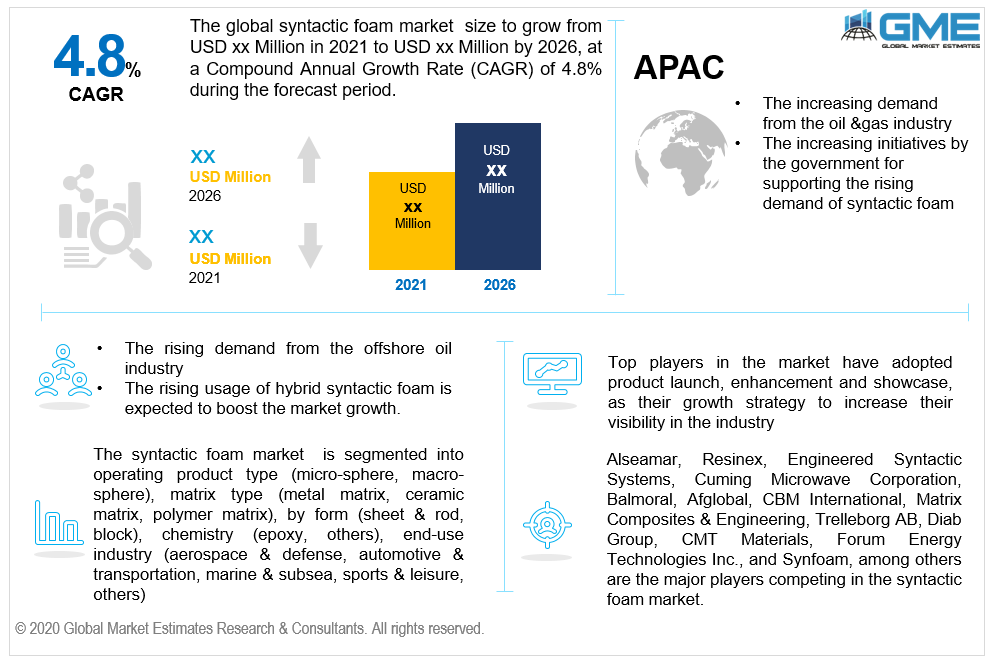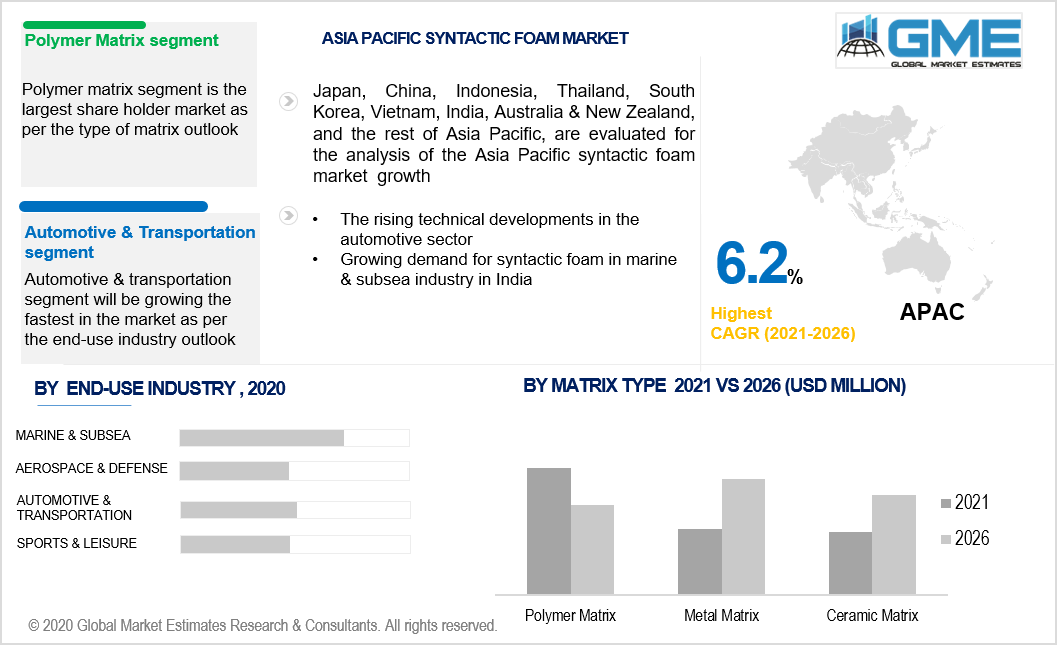
Global Syntactic Foam Market Size, Trends, and Analysis- Forecasts To 2026 By Product Type (Micro-Sphere, Macro-Sphere), By Matrix Type (Metal Matrix, Ceramic Matrix, Polymer Matrix), By Form (Sheet & Rod, Block), By Chemistry (Epoxy, Others), By End-Use Industry (Aerospace & Defense, Automotive & Transportation, Marine & Subsea, Sports & Leisure, Others), By Region (North America, Asia Pacific, CSA, Europe, and the Middle East and Africa); End-User Landscape, Company Market Share Analysis & Competitor Analysis
Syntactic foam is a lightweight, high-strength material that is produced by using hollow spheres and are bound together with a thermoset polymer, which is usually made of glass. During the forecast timeframe, the growing use of hybrid syntactic foams along with growing ultra-deep-water & deep-water activities is expected to support market growth. The market demand will be growing due to rising cost optimization in offshore oil & gas projects and technological advances around the globe. Furthermore, rising demand from various end-use industries is anticipated to fuel the growth of the market for syntactic foam between 2021 and 2026.

The three different types of matrices are metal matrix, ceramic matrix, and polymer matrix. The polymer matrix segment holds the largest market share over the projected timeline. This is due to the growing demand for marine & subsea applications such as underwater robotics, automobiles, flotation, pumps, and insulation of oil & gas pipelines.
According to the product outlook, all segments are micro-sphere and macro-sphere. The biggest market shareholder in 2020, was the micro-sphere segment in terms of value and volume. Microsphere syntactic foam is entirely composed of hollow glass and resin microspheres. Usually, this isotropic material is supplied in block form and is available in various densities, and is designed to meet requirements for depth and buoyancy down to 10,000 meters and hence it has the highest share.
The two forms of syntactic foam are sheet & rod, and blocks. It is expected that the blocks segment will dominate the market from 2021 to 2026. To build larger structures blocks are highly used for the bonding process. Machined surfaces are smooth and need no additional coating to prevent deep water absorption, but are also skinned or painted to shield the surface from impact or visibility.
The end-user segment is divided into three categories including aerospace & defense, automotive & transport, marine & subsea, and sports & leisure, among others. The market is will witness the dominance of the marine & subsea segment over the anticipated timeframe. The growth of this segment is being driven by rising ultra-deep-water and deep-water activities.

The dominant market segment is held by the North American region in terms of revenue growth. This is due to the growing use of syntactic foam in the leisure and marine & subsea industries, and the rising demand for syntactic foam from the offshore oil industry. On the other hand, the Asia Pacific region will be the fastest-growing region due to the increasing demand from the automotive industry, sports, and healthcare sectors. The rising technical developments in the automotive sector are likely to fuel the market demand for syntactic foam.
Alseamar, Resinex, Engineered Syntactic Systems, Cuming Microwave Corporation, Balmoral, Afglobal, CBM International, Matrix Composites & Engineering, Trelleborg AB, Diab Group, CMT Materials, Deepwater Buoyancy, Acoustic Polymer Ltd., Forum Energy Technologies Inc., and Synfoam, among others are the major players competing in the syntactic foam market.
Please note: This is not an exhaustive list of companies profiled in the report.
In May 2020, Deepwater Buoyancy launched its product pop-up buoy recovery method (PUB) for the Sonardyne LRT acoustic release. The recovery buoy is made of DeepTec rigid syntactic foam of high strength.
We value your investment and offer free customization with every report to fulfil your exact research needs.
The Global Syntactic Foam Market has been studied from the year 2019 till 2026. However, the CAGR provided in the report is from the year 2021 to 2026. The research methodology involved three stages: Desk research, Primary research, and Analysis & Output from the entire research process.

The desk research involved a robust background study which meant referring to paid and unpaid databases to understand the market dynamics; mapping contracts from press releases; identifying the key players in the market, studying their product portfolio, competition level, annual reports/SEC filings & investor presentations; and learning the demand and supply side analysis for the Syntactic Foam Market.

The primary research activity included telephonic conversations with more than 50 tier 1 industry consultants, distributors, and end-use product manufacturers.

Finally, based on the above thorough research process, an in-depth analysis was carried out considering the following aspects: market attractiveness, current & future market trends, market share analysis, SWOT analysis of the companies and customer analytics.

Tailor made solutions just for you
80% of our clients seek made-to-order reports. How do you want us to tailor yours?
OUR CLIENTS